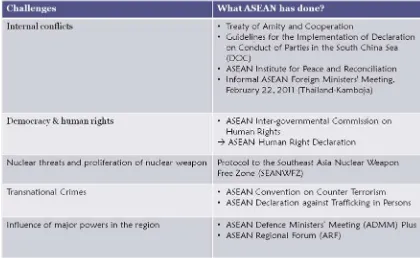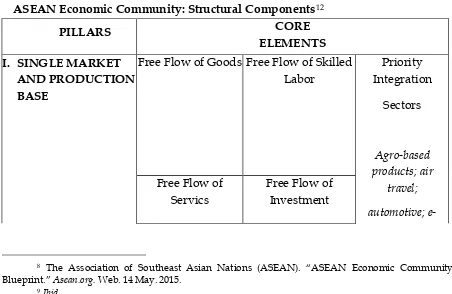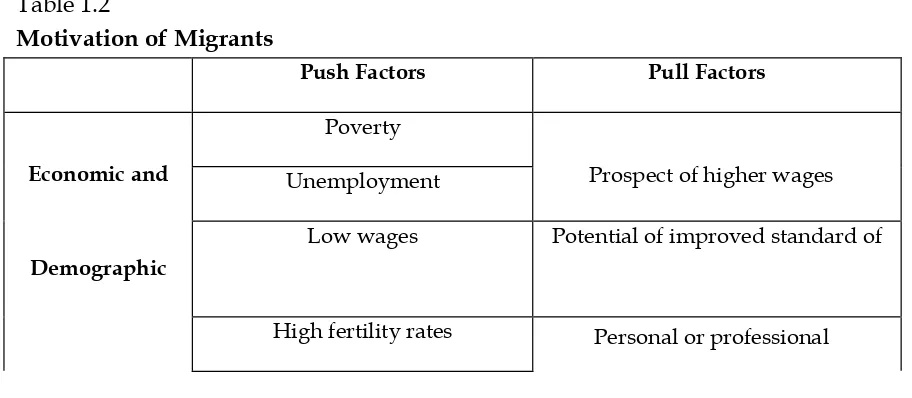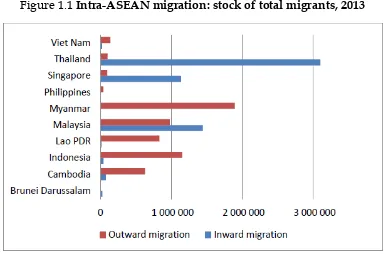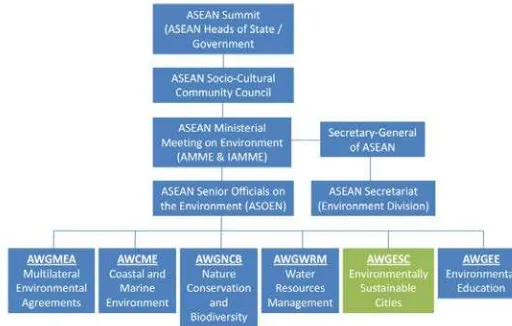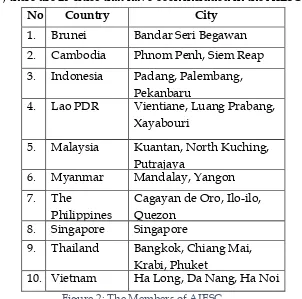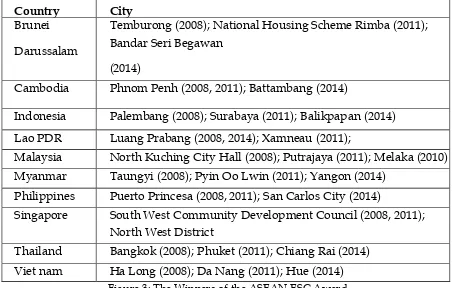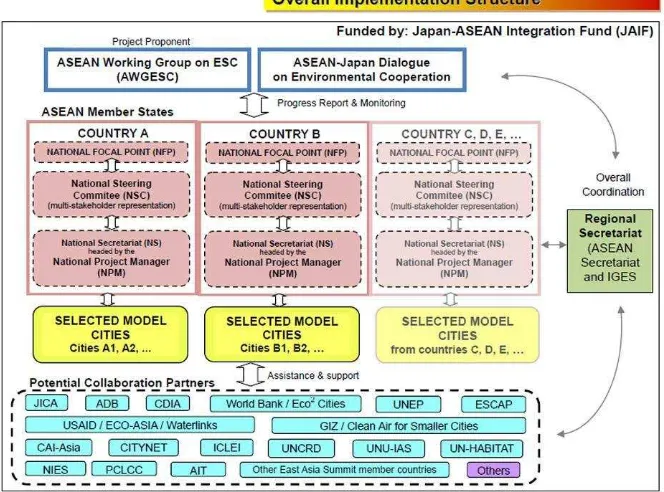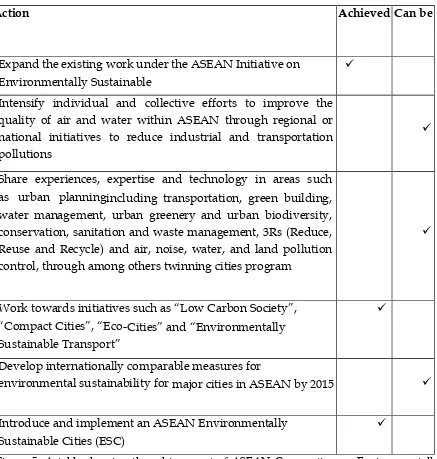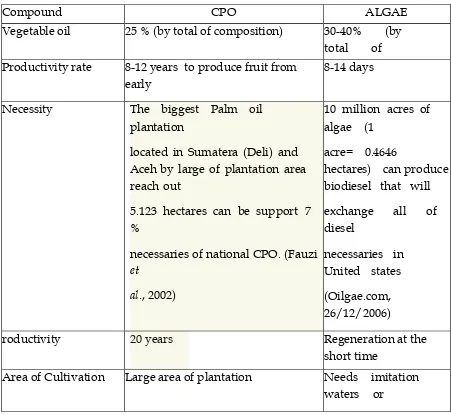PROCEEDING ICOSEAS
Toward the ASEAN Community:
Assessing The South East Asia`s Integration
Proceeding Books
By Department of International Relations, Faculty of Psychology and Social Sciences Universitas Islam Indonesia
For the International Conference on South East Asian Studies Volume I,
EDITORIAL BOARD
Advisor :
Irawan Jati, M.Hum, MS
Head :
Hangga Fathana, MA
Editor :
Hasbi Aswar, MA
Managing Editor :
Gustrieni Putri, MA Enggar Furi Herdianto, M Karina Utami Dewi, MA
Design & Layout :
Widodo HP
Februari 2016, Printed in Yogyakarta
ISBN:
9772443331003
Published by:
Department of International Relations FPSB Universitas Islam Indonesia Yogykarta
Host by:
FOREWORDS
Southeast Asia Study has become increasingly significant. This is due to the fact that Southeast Asia is a highly dynamic region which centered on ASEAN as the economic powerhouse. The existance of ASEAN has changed the international architecture of Southeast Asia from distrust to community committment to create the prosperity and stability to the region. However, ASEAN committment to advance the region is challanged by some issues. The first is the question of ASEAN committment on human rights issue, as shown in the case of irregular or forced migration of Rohingans from Myanmar. The second issue is the disparity of political systems and economic capacity among ASEAN members. At this point, ASEAN member states are generally divided into two groups, the founding fathers (Indonesia, Malaysia, Singapore, Thailand, the Philippines) and new members (Brunei Darussalam, Cambodia, Laos, Myanmar, and Vietnam). The founding fathers states are economically more stable compare to the new members except Brunei Darussalam. It takes ASEAN to adjust some of its economic policies. The third challange is the United States and China contest in Southeast Asia. This is probably the most challanging aspect of ASEAN in which it should play smart diplomacy in dealing with both major powers. Therefore, the International Conference of Southeast Asia Studies is set to take part in identifiying and analysing key issues surrounding Southeast Asia.
Yogyakarta, December 2015
Department of International Relations Chairperson,
TABLE OF CONTENTS
Foreword ... v Table of Contens ... vi
CHAPTERI : POLITICAL ISSUES IN ASEAN INTEGRATION PROCESS
1. ASEAN Political Security Community: Problems, Challenges, and Prospects
Ludiro Madu ... 1 2. A Threat towards ASEAN Community: "Brain Drain" as an Effect of
Southeast Asia's Integration
Septyanto Prakoso, Niki Wahyu Sayekti ... 15 3. China and the ASEAN: A Need for Shifting Paradigm
Dedi Dinarto ... 29 4. Regional Trade Blocs and Development Cooperation: Examining the
ASEAN Economic Community as a Facilitator of South-South Development Assistance
Tanner Boisjolie ... 43 5. Diplomatic Governance initiatives on Formulating and Articulating
Indonesian foreign Policy
Ratih Herningyas, Surwandono, Tulus Warsito ... 61 6. Environmental Paradiplomacy: Utilizing ASEAN Cooperation on Environmentally Sustainable City as a Tool to Achieve an Integrated Sustainable Region
Ario Bimo Utomo ... 73
CHAPTER II ECONOMY ISSUES IN ASEAN INTEGRATION
7. The Emerging Importance Of Asean Defense Ministerial Meeting In Strengthening Asean Economic Community: A Political Economy Of Security Analysis
Semmy Tyar Armandha ... 93 8. “MIOP” (Microalgae Integrated Offshore Plant) Optimization of Biodiesel
Production In Indonesian Offshore Area By Utilizing Microalgae as One Of Prime Export Commodities to Face
Agus Candra, Eka Pertiwi ... 107 9. ASEAN Japan Comprehensive Economic Partnership and its Contribution
to Southeast Asia Regionalism,
CHAPTER III: SOCIAL, CULTURAL & MEDIA ISSUES IN ASEAN INTEGRATION
10.Conflict Prevention through ASCC: The Power of its People, Impact for Regional Peace and Security.
Emil Radhiansyah, Jerry Indrawan ... 133 11.Managing Cultural Diversity of Southeast Asia: ASEAN Socio-cultural
Community Framework
Jusmalia Oktaviani, Teguh Puja Pramadya ... 147 12.Higher Education in Post Conflict Area toward Southeast Asia
Integration: Study Case on Nanggroe Aceh.
Randhi Satria, Nyphadear Tiara S.A.P, Wiwit Putri Handayani ... 161 13.Enhancing ASEAN Integration: The Role of AYLA as a Youth
Organization to Participate in ASEAN Integration.
Panji Raga, Muh. Hidayat Hasan ... 175 14.Strengthening Asean Women’s Partnership in Dealing With The Effects of
Forest Fires in Southeast Asia.
Dina Oktarina, Yasinta Dewi, Salieg Luki Munestri ... 189 15.Enhancing ASEAN Financial Literacy for Better Economy and Shared
Prosperity
Kiky Srirejeki ... 203 16.PKPU (Pos Keadilan Peduli Umat) As a Role Model for Philanthropic
Organization in Southeast Asia.
Adhitya Choirul Latif, Nyphadear Tiara S.A.P, Leni Winarni ... 215 17.The News Coverage of Indonesia Media toward AEC
Heditia Syahputri Damanik ... 229 18.Nasakom Politic of Soekarno in 1960-1967 (Literature Study of Politic,
Social, and Economic Situation).
CHAPTERI:
POLITICAL ISSUES IN ASEAN
ASEAN POLITICAL SECURITY COMMUNITY: PROBLEMS, CHALLENGES AND PROSPECT
Ludiro Madu, MSc.
Dept. of International Relations UPN “Veteran” Yogyakarta Email: ludiro@gmail.com
ABSTRACT
This paper seeks to understand the dynamics of ASEAN Political Security Community (APSC) in managing on-going and potential conflicts and establishing regional peace in Southeast Asia. Particular elaboration will focus on its problems, challenges, and its prospects for building security community among ASEAN‟s member states. The APSC is designed to promote political and security cooperation among the ASEAN member states and seeks to make it possible for the member states to live in peace with one another and with the world at large in a just, democratic and harmonious environment. Unfortunately, various intra- and inter-state conflicts occurred since its establishment which, in turn, challenges the efficacy of ASPC in managing and solving those problems. ASEAN has done various efforts for building regional institution with the purpose of taking care of specific regional issues, such as ASEAN Convention on Countering Terrorism (ACCCT), ASEAN Humanitarian Action (AHA) Center, ASEAN Agreement on Transboundary Haze and Pollution (AATHP), ASEAN Intergovernmental Convention on Human Rights (AICHR). Those regional institutions have helped ASEAN member states in promoting traditional and non-traditional security threats among them. However, institutional efforts that the APSC has done seems to find unresolved problems, such as border problems, transnational drugs and human trafficking issues, illegal fishing, and conflicted claims between some ASEAN members and China. The fact that APSC has built some regional mechanism for managing specific problems has found reality of emerging new unfinished problems. Consequently, APSC has to deal with its uncertain prospect in building regional stability approaching the implementation ASEAN Community by the end of 2015.
Keywords: ASEAN, APSC, Security Community, regional regimes
Introduction
One of the most important developments in preparing ASEAN Community 20151 is the dynamics of ASEAN Political Security Community (APSC) in
managing on-going and potential conflicts and establishing regional peace in Southeast Asia. As one of its three pillars, APSC is designed to promote political and security cooperation among the ASEAN member states and sought to make it possible for the member states to maintan peaceful, democratic and harmonious environment in the region. APSC serves as a regional mechanism for building a firm and sustainable foundation for regional security and peace in Southeast Asia. The APSC Blue Print that was adopted by the 14th ASEAN Summit in 2009 specified
three key basic areas, as follows: (i) a rule-based community with shared values and norms; (ii) a cohesive, peaceful and resilient region with shared responsibility for comprehensive security; (iii) a dynamic and outward looking region.2
Those basic areas formed a set of norms, regulations or rules which has indirectly built regional regimes in ASEAN. Within less than one month, APSC has arranged various regional institutional regimes for managing potential conflicts and building sustainable peace in the region, including those of non-traditional threats. ASEAN‟s member states has struggled hard in negotiating these regimes, such as in the areas of countering terrorism, trans- boundary haze and pollution, human rights, transnational organized crimes, and humanitarian action. The magnitude of the problems, and their impacts beyond national boundaries, render any national response inadequate. In other words, the nature of non- traditional security problems requires not only national response but also close regional cooperation to address them.3
This regional organization, however, has to deal with various on-going potential conflicts in the issues of border, human trafficking, refugees, drugs, and other maritime problems. These problems seem to hinder ASEAN’s serious attempts in promoting regional peace. Therefore, ASEAN needs to find out alternative means to continue its target of implementing APSC by the end of 2015, while at the same time ASEAN has also tried hard in managing potential regional conflicts among its member states.
Security Community: A Brief Overview
As the implementation of the Bali Concord II (2003), APSC is ASEAN‟s next big step in formalizing and institutionalizing the ASEAN‟s community vision into a concretely targeted Community by 2020. ASEAN strongly admitted the need for greater and faster regional integration in order to remain competitive and relevant in
ASEAN Community as “One Vision, One Identity, One Community” would be brought up to 2015. The idea of the ASEAN Community was finalized in the new ASEAN Charter at the 13th ASEAN Summit in November 2007, when all the heads of the member governments signed the charter. One year later, the new charter was accepted by the parliaments of all ten member countries.
2 “ASEAN Political Security Community Blue Print”, p. 3, accessed at
www.aseansec.org/22337.pdf
the fast changing regional landscape. The three pillars of Community goal, which was subsequently accelerated to 2015 at the 12th ASEAN Summit in 2007, was a
major advancement of the ASEAN community vision because it made community building the most important objective of ASEAN. It was recently argued, rationally, that ASEAN needed to think about the Community‟s further development beyond 2015.4
Before it comes into the recent form, APSC was initially only security community.5 Borrowing from Karl Deutsch, security community (SC) isa group that
has become “integrated”, where integration is defined as the attainment of a sense of community, accompanied by formal or informal institutions or practices, …..to assure peaceful change among members of a group with reasonable certainty over a long period of time…. Such community could either be amalgamated” through the formal political merger of the participating units, or remain “pluralistic”, in which case the members retain their independence and sovereignty.6
For Deutsch, there are two types of SC. The first is Amalgamated Security Community (ASC) which amalgamates two or more independent units into one bigger entity of state-government. The second one is Pluralistic Security Community (PSC) which maintains independency and sovereignty of different units. States in PSC would have shared values through various institutions and shared responsibility to build one identity – we feeling. Different from ASC, states the PSC maintain their national sovereignty and commit to build shared identity and loyalty which is based on, both stable order and stable peace.7 All in all, ASEAN
fits more to PSC than ASC.8
In the context of Southeast Asia, Rizal Sukma (2003) proposed ASEAN to become a comprehensive security community (CSC) which would be “more attuned to the region‟s own needs and characteristics…. go beyond military security to give equal importance to the non-military kind and move beyond war-prevention to prevent and resolve conflicts and disorder.”9 Looking back at the Bali Concord II,
it is obvious that ASEAN will achieve a “Pluralistic Security of Community”. This
4 Nguyen Hung Son, “The ASEAN Political Security Community: Challenges and Prospect”, Paper presented at the International Conference on ASEAN Vision 2015: Moving Towards One Community, Taipei, 24-25 May 2011, p. 6.
5 The concept of ASEAN Security Community that Indonesia proposed at the 9th ASEAN Summit in Bali was much inspired by Rizal Sukma’s paper entitled “The Future of ASEAN: Towards a Security Community”. Sukma presented his paper at a seminar on ASEAN Cooperation: Challenges and Prospects in the Current International Situation, New York, 3rd June 2003.
6 Karl W. Deutsch, et.al., Political Community and the North Atlantic Area: International
Organizaiton in the Light of Political Experience, Princeton University Press, N.J., 2957. 7Ibid., p. 5.
8 For further analyses on whether ASEAN can be categorized, either as loosely coupled pluralistic security community or thick PSC, see Donald K. Emmerson, “Security, Community, and Democracy in Southeast Asia:Analyzing ASEAN”, Japanese Journal of Political Science, 6 (2), 2005, pp. 165-85.
kind of SC will not move ASEAN towards a regional political and security “entity‟ with a joint foreign policy.
Another important aspect is that Sukma’s proposal and the Bali Concord II actually mention two fundamental issues separately which have given stronger foundation for ASEAN in commiting to universal norms. On one hand, Rizal’s “proposal” did mention “human rights”, but did not mention “democracy”. On the other hand, BC II did mention “democracy”, but did not mention “human rights”.10
Nevertheless, both have promoted an ASEAN Political Security Community in its recent development which has strong commitment in upholding democratic and harmonious environment in Southeast Asia.
APSC and Its Dynamics a. Problems and Challenges
One often cited problem in monitoring ASEAN Community building progress is the lack of quantifiable targets, particularly in the Political Security pillar. To “Promote understanding and appreciation of political systems, culture and history of ASEAN Member States” as called for in article A1.1 of the Blue Print, the actions requirements are “Encourage the holding of at least two track-two events per year.” and “Intensify exchange of experience and training courses...”, all with no clear quantified targets. On the other hand, a very notable qualitative progress was achieved with ASEAN breaking the boundary of its cooperation by developing cooperative activities, new norms and slowly new rules in difficult areas, some even considered untouchable before.
ASEAN advocates would have been right in saying that Southeast Asia is a war- free zone. However, ASEAN being war-free does not guarantee that ASEAN member states would not face internal conflict and tension.11 Recent events in the
region reflected stark differences among member states in the ASEAN region. We have, first and foremost, the diverse nature of ASEAN politics. We have a state bound by military rule, one a Communist state, a sultanate, single-party states, and struggling democracies.
We also find different levels of development among member states. Some analysts have lauded the progress of economic integration in the region. However, one cannot dissociate economic conditions from political and security issues. Where there is corruption, poor governance and political upheaval, there will always be, in turn, economic upheaval as well.
10 Phillip J. Vermonte, “ASEAN Political Security Community:Where is It Going” paper presented at the Habibie Center on Talking ASEAN on Democracy, 26 November 2014.
On regional regimes, the ASEAN inter-governmental commission on human rights is one of such achievement, considering that human rights issues were once seen as too sensitive to appear in any ASEAN‟s formal discussions. ASEAN managed to advance its cooperation on maritime security, despite maritime boundaries disputes among its members. An ASEAN Maritime Forum was inaugurated in 2010 after years of consideration; an enhanced discussions on the South China Sea in ASEAN’s high level meeting; and an ASEAN Declaration on Search and Rescue of People and Vessels in distress at sea. All of these regional aggreement reflected rising confidence among member states to touch upon issues considered too sensitive before, a positive sign that some community sense is under formation.
Weak political commitment of ASEAN member states, and the lack of direct intervention on the policies and programs of ASEAN significantly hinders the move of member states to ensure peace and stability in the region.12 On one
hand, the ASEAN Secretariat functions less like an implementing agency and more of a post or liaison office, with insufficient power to direct and implement policies and programs outlined in the APSC framework. Meanwhile, the ASEAN Summit, considered the highest policymaking body, is weak and ineffective in enforcing rules and principles among member states.13
ASEAN cannot simply uphold its principle of non-interference to address the problem. With changes in the political climate in the region, the “ASEAN Way” has somehow offered limited opportunities to help promote democracy and achieve peace and stability in the region.14 It has hindered the effectiveness of
dispute settlement and conflict resolution mechanisms. Inherently, it also contrasts with the goals of the ASEAN Political and Security Community framework, which demands direct intervention to promote peace and security.
Approaching the implementation of the ASEAN Community by early 2016, the important role of community or people or society must be taken into consideration. Promoting involvement of people is of increasingly importance for showing the strong commitment of the 2015 ASEAN Community.
As community regards people, instead of state or government officials, ASEAN should make sure people or society takes important role in discussing various issues which would influence their regional cooperation. ASEAN has undoubtedly given much role to state‟s official in developing the regional
12 Sukma, “ASEAN and Non-Traditional...”, op.cit., p. 4
13 Roby Arya Brata, “Building the ASEAN Political Security Community, the Jakarta Post, 5 February 2013.
organization, however, ASEAN must strengthen its commitment to shift its labbelling from “civil servant” to “civil society”.15
All of abovementioned problems have been unfinished, although recent developments have also shown some progress in promoting people’s participation in regional level within ASEAN. While other problems still exist and will become ASEAN’s challenges in future. Those problems directly challenges the efficacy and capacity of the ASPC in managing and solving those regional issues, without any potential interference towards domestic affairs of each ASEAN’s member states.
b. Some Developments
The ASEAN Political Security Community Blue Print foresees a dynamic and outward looking ASEAN, which means the ASEAN Community would not be realized without the outside world recognizing its relevance and lending support to it. Indeed, from its inception, external relations has always been an important pillar to ASEAN‟s cooperation, and strategically ASEAN has always maneuvered at times of geo-political change and come up with solutions in order to stay relevant. ASEAN‟s initiatives such as the Zone of Peace, Freedom and Neutrality was ASEAN‟s reaction to the changing Sino-US relationship and its implications to the region; the ASEAN Regional Forum was ASEAN reaction to the US diverting its attention from the region amid the end of the cold war; theASEAN+3 process was inaugurated on the wake of the regional financial crisis.
ASEAN has done various efforts for building regional institution with the purpose of taking care of specific regional issues, such as ASEAN Convention on Countering Terrorism (ACCCT), ASEAN Humanitarian Action (AHA) Center, ASEAN Agreement on Transboundary Haze and Pollution (AATHP), ASEAN Intergovernmental Convention on Human Rights (AICHR). Those regional institutions have helped ASEAN member states in promoting traditional and non-traditional security threats among them.
15 Ludiro Madu, “ASEAN 2011-2013: Bringing Non-State Actors Back In”, paper presented at
the International Conference on International System on the End of the Westphalian Settlement: Contemporary Global Challenges Towards the Nation-State System, Universitas Muhammadiyah Yogyakarta,
Table 1. ASEAN’s Challenges and Its Responses
Although various regional regimes has been set up, the critical challenge for the APSC has always been building regional confidence among ASEAN‟s own members and between ASEAN‟s members and the regional and global partners they frequently engage with. Given the rapidly changing geo-political and strategic environment in the region, enhancing confidence should be central to the Community building process. It is no secret that while confidence among ASEAN members has been greatly improved, ASEAN members still seriously lack confidence on certain issues, most notably territorial disputes. Thailand – Cambodia ongoing conflict is a case in point. ASEAN members must maintain frank and open dialogues on any issues that affect their changing security environment or interests, their threat perceptions and national strategies to deal with those threats. Another encouraging results were observed in 2010 when ASEAN broke silence and discussed the South China Sea issue in an open and constructive manner.16
ASEAN members will also need to overcome rising nationalism to think beyond national boundaries and balance out regional versus national interests. A “we feeling” must be developed both from the grass-root level up and from top down. Better cooperation and coordination between and within each Community pillars‟ activities is needed to ensure higher operational efficiency,
16 Y. F. Khong, “Coping with Strategic Uncertainty: The Role of Institutions and Soft Balancing in Southeast Asia‟s Post-Cold War Strategy” in J. J. Suh, P. J. Katzenstein and A. Carlson (eds.),
but for this to happen member states need to successfully address cross-sectoral issues both at national and regional level.
Amidst the current wave of changing regional environment due to the rise of China and India, the return and re-engagement of the US with the region, ASEAN has been actively trying to stay relevant and remain a driving force in the regional architecture through series of initiatives, most notably the creation of the ASEAN Defense Ministers Meeting Plus and the expansion of the East Asia Summit to include key military and economic powers, including Russia and the United States. The challenge is not only for ASEAN to be able to “drive” much larger and powerful “passengers”, but more importantly to drive the processes in the way that ensure ASEAN’s vital interests, i.e.to preserve ASEAN’s priorities and agendas, which at the moment is to successfully build the ASEAN Community by 2015.17
On a longer run, to stay relevant in the regional architecture, ASEAN will need to deliver not just a neutral ground for the major powers to interact, but also effective instruments and sometimes innovative ideas to address very specific problems facing the region.18 ASEAN’s instruments such as the Treaty of
Amity and cooperation (TAC), the South East Asia Nuclear Free Zone (SEANFWZ), and the Declaration of Conduct of the parties in the South China Sea (DOC) etc. must be made to work. The TAC has been increasingly accepted by non-regional countries as ASEAN‟s ground rules they must obey to interact with the region. The DOC is another critical instrument to keep peace and stability in the region, and the instrument was referred to regularly by ASEAN and China while dealing with the situations in the South China Sea. However, the DOC‟s implementation suffer from different interpretation of its somewhat vague provisions, for example what “exercise maximum self restrain” means in very specific scenarios, while a set of guidelines to implement the DOC has yet to be finalized.
The fact that APSC has built some regional mechanism for managing specific problems has found reality of emerging new unfinished problems. APSC has to deal with its uncertain prospect in building regional stability approaching the implementation ASEAN Community by the end of 2015. Allthough some institutional efforts has done, the APSC has to keep its grip in finding out regional solutions for border problems, transnational drugs and human trafficking issues, illegal fishing, and conflicted claims between some ASEAN members and China.
17 Rizal Sukma, „ASEAN and the Major Powers in the New Emerging Regional Order‟ in J. Tsunekawa (ed.), Regional Order in East Asia: ASEAN and Japan Perspectives, NIDS Joint Research Series No. 1, National Institute for Defense Studies, Tokyo, 2007, p. 83.
Prospects
In tackling the regional comprehensive security, ASEAN relies much on internal as well as external cooperation. Internally, ASEAN is becoming more pro-active and more direct in addressing internal security problems. The creation of the ASEAN Defense Ministers Meeting mechanism is an effort to build confidence among the most important security sector which has long been considered sensitive even for dialogue, let alone cooperation. ASEAN has opened up dialogue among its security chief as well, with their first meeting held in Hanoi in 2010. The ASEAN Secretariat plays increasingly active roles in mobilizing support and coordinates efforts to tackle non- traditional security issues like disaster relief, communicable diseases, etc. The ASEAN Secretariat, for example, played a central role in ASEAN response following the Nargis typhoon in Myanmar; as well as several other natural disasters in the region.19 ASEAN in 2011 was seen to play
an active role as well in mediating conflict among its members, in particular the ongoing Thailand – Cambodia conflict, thanks to Indonesia, the current ASEAN’s chairman. Externally, ASEAN has been using the ASEAN Regional Forum as the leading mechanism to build confidence and improve the regional security environment. The ARF has adopted a Vision Statement in 2009 and in 2010 built a concrete Action Plan to realise the Vision; has agreed to explore some preventive diplomacy measures along with measures to build confidence in the region.
ASEAN Community building, including its Political and Security pillar, is a continuously learning process for ASEAN. ASEAN depth and scope of integration within the organization as well as with the international community has gradually evolved and will continue to evolve, much depending on ASEAN‟s own effort but also depend on the regional environment that ASEAN is bound to. The current changing regional environment presents a major opportunity for ASEAN to enhance its relevance and role in the regional architecture, thus mobilizing support for its Community building effort. However, the new environment also poses many critical challenges to the organization. ASEAN must therefore find a balanced approach to its external relations and internal community building process that best serve its interests.
The ASEAN Political Security Community Blue Print foresee a dynamic and outward looking ASEAN, which means the ASEAN Community would not be realized without the outside world recognizing its relevance and lending support to it. Indeed, from its inception, external relations has always been an important pillar to ASEAN’s cooperation and strategically ASEAN has always maneuvered at times of geo-political change and come up with solutions in order to stay relevant.
has been actively trying to stay relevant and remain a driving force in the regional architecture through series of initiatives, most notably the creation of the ASEAN Defense Ministers Meeting Plus and the expansion of the East Asia Summit to include key military and economic powers, including Russia and the United States. The challenge is not only for ASEAN to be able to “drive” much larger and powerful “passengers”, but more importantly to drive the processes in the way that ensure ASEAN‟s vital interests, i.e. to preserve ASEAN’s priorities and agendas, which at the moment is to successfully build the ASEAN Community by 2015.
On a longer run, to stay relevant in the regional architecture, ASEAN will need to deliver not just a neutral ground for the major powers to interact, but also effective instruments and sometimes innovative ideas to address very specific problems facing the region. ASEAN‟s instruments such as the Treaty of Amity and cooperation (TAC), the South East Asia Nuclear Free Zone (SEANFWZ), and the Declaration of Conduct of the parties in the South China Sea (DOC) must be made to work. The TAC has been increasingly accepted by non-regional countries as ASEAN’s ground rules they must obey to interact with the region.20
In doing so, ASEAN has depend much on the leading role of Indonesia in regional level. The former ASEAN Secretary General Rodolfo Severino has outlined four reasons Indonesia was important to the development of ASEAN. Firstly, he argues that ASEAN was created only after Indonesia changed its foreign policy approaches in the aftermath of the downfall of the Sukarno regime. Jakarta subsequently agreed to join four other founding Regional nations – Malaysia, the Philippines, Singapore and Thailand – to form ASEAN in 1967. Secondly, throughout ASEAN history, Indonesia has played a leadership role in the organization. The country was also the forerunner for the ASEAN’s 2003 Political Security Community initiatives and took a leadership role21 in the drafting of the
Plan of Action for the ASEAN Security Community in 2004. Moreover, its role and contribution to the organization encompass political as well as economic dimensions.
ASEAN Community building, including its Political and Security pillar, is a continuously learning process for ASEAN. ASEAN depth and scope of integration within the organisation as well as with the international community has gradually evolved and will continue to evolve, much depending on ASEAN’s own effort but also depend on the regional environment that ASEAN is bound to. The current changing regional environment presents a major opportunity for ASEAN to enhance
20 Ludiro Madu, “Pertaruhan Sentralitas ASEAN,” Suara Merdeka, 16 May 2014.
its relevance and role in the regional architecture, thus mobilising support for its Community building effort.22
Concluding Remarks
APSC has built some regional mechanism for managing specific problems has proved its capability in managing regional problems in the region. The fact that those problems have been unfinished found APSC in its best place in managing and preventing the escalation of those problems into conflicts among ASEAN‟s member states. Accordingly, APSC has to deal with those problems for building regional stability approaching the implementation ASEAN Community by the end of 2015.
Those regional institutions have helped ASEAN member states in promoting traditional and non-traditional security threats among them. However, institutional efforts that the APSC has done seems to find unresolved problems, such as border problems, transnational drugs and human trafficking issues, illegal fishing, and conflicted claims between some ASEAN members and China. Approaching the implementation of ASEAN Community, APSC has built strong institutional foundation and regional mechanism for managing problems and anticipating potential conflicts.
ASEAN’s capability in dealing with those problematic issues in regional level would give stronger push to move forward and determine its prospect in future.
References
“ASEAN Political Security Community Blue Print”, p. 3, accessed at
www.aseansec.org/22337.pdf
Brata, Roby Arya, “Building the ASEAN Political Security Community, the Jakarta Post, 5 February 2013.
Deutsch, Karl W. (et.al.), Political Community and the North Atlantic Area: International Organizaiton in the Light of Political Experience, Princeton University Press, N.J., 2957
Emmerson, Donald K., “Security, Community, and Democracy in Southeast Asia: Analyzing ASEAN”, Japanese Journal of Political Science, 6 (2), 2005, pp. 165-85.
Krishnan, G., Democracy Building in ASEAN: A Case for EU Subregional Engagement, Stockholm, International Institute for Democracy and Electoral Assistance, Sweden, 2010.
Madu, Ludiro, “ASEAN‟s Soft Balancing Strategy Between the US and China: The Case of South China Sea Dispute”, paper presented at the 1st FISIP‟s national conference, UPN “Veteran” Yogyakarta, 2013.
..., “ASEAN 2011-2013: Bringing Non-State Actors Back In”, paper presented at the International Conference on International System on the End of the Westphalian Settlement: Contemporary Global Challenges Towards the
Nation-State System, Universitas Muhammadiyah Yogyakarta, Yogyakarta, 11th
November 2013.
..., “Pertaruhan Sentralitas ASEAN,” Suara Merdeka, 16 May 2014.
Beginda Pakpahan, “Internal and External Challenges for ASEAN in the evolving regional architecture”, paper presented at Talking ASEAN on ASEAN Regional Forum, the Habibie Center, Jakarta, 27 August 2014.
Severino, Rudolfo C. (2006), Southeast Asia In Search of an ASEAN Community: Insights from the Former ASEAN Secretary General, Singapore: Institute of Southeast Asian Studies.
Son, Nguyen Hung, “The ASEAN Political Security Community: Challenges and Prospect”, Paper presented at the International Conference on
ASEAN Vision 2015: Moving Towards One Community, Taipei, 24-25 May
2011, p. 6.
Sukma, Rizal, “The Future of ASEAN: Towards a Security Community”, presented at a seminar on ASEAN Cooperation: Challenges and Prospects in the Current International Situation, New York, 3rd June 2003.
..., “ASEAN and the Major Powers in the New Emerging Regional Order” in J. Tsunekawa (ed.), Regional Order in East Asia: ASEAN and Japan
Perspectives, NIDS Joint Research Series No. 1, National Institute for Defense
Studies, Tokyo, 2007, p. 83.
..., “ASEAN and Non-Traditional Security”, CSIS, Jakarta, 3 December 2010. Vermonte, Phillip J., “ASEAN Political Security Community: Where is It Going”
paper presented at the Habibie Center on Talking ASEAN on Democracy, 26 November 2014.
A THREAT TOWARD ASEAN COMMUNITY: “BRAIN DRAIN” AS AN EFFECT OF SOUTHEAST ASIA’S INTEGRATION
Septyanto Galan Prakoso, SIP., M.Sc1 Co-author: Niki Wahyu Sayekti2
ABSTRACT
By the end of December 2015, ASEAN Economic Community (AEC)will come into effect and it will transform ASEAN into a region with free movement of goods, services, investment, skilled labor, and freer flow of capital.3
Following that condition, the free movement of labor or human resources will happen. This condition is expected to be able to raise the level of competitiveness inside ASEAN society so that it would contribute to the development of the region. However, the easy access provided by the AEC for people to move out from one country to another in the ASEAN region can also emerge a new threat known as “brain drain”. Brain drain is a situation which large numbers of educated and skilled people leave their own country to live and work in another one where pay and conditions are better.4When AEC is implemented, people who
have skills from member countries in ASEAN which have weaker economic powerwould most likely choose to leave their country to another member countires which has better economic condition. Therefore, the development of the region dreamt by the ASEAN member countries will be harder to achieve. There will be a higher disparity between countries, and from the social dimension, this problem of brain drain would not only cause disadvantages from the origin countries but also for the host countries.
Hence, ASEAN member countries must find solutions to surmount the threat of brain drain to ensure the success of Southeast Asia Integration through AEC.
Keywords: brain drain, free movement of labor, ASEAN Economic Community
INTRODUCTION
The deadline of the implementation of ASEAN‟s ambitious grand agenda, the AEC (ASEAN Economic Communities), is approaching slowly but sure. Ready or not, by the end of December 2015, or by the end of this year, ASEAN member countries will have to welcome and approve it one way or another as what had been agreed. ASEAN Economic Community (AEC) itself aims to attain a
1 Is a lecturer in International Relations Department, Universitas Sebelas Maret, Surakarta, Indonesia and Bakrie Graduate Awardee 2012-2013
2 Is an undergraduate student in International Relations Department, Universitas Sebelas Maret, Surakarta, Indonesia.
single market and production base, allowing the free flow of goods, services, investments, and skilled labor, and the free movement of capital across the ASEAN region.5
Regarding the formation of AEC itself, sounds of optimism and hopes can be heard as voiced out by the member countries where this economic integration is expected to contribute to the development for the region and change the face of ASEAN itself into a better one. However, despite of the opportunities and potentials brought by the AEC, there are emerging threats that should be noticed by the member countries from this initiative of economic integration. One of the threats comes from the aspect of human capital or skilled labors flows. The free movement or exchange of skilled human resources in the region is expected by member countries to be able to provide wider job opportunities, raise the level of competitiveness of ASEAN society, as to shape common identity of people as ASEAN citizen.
Nevertheless, it seems that the member countries of ASEAN missed to perceive the potential threat or problem created by such mechanism of the free flow of skilled human capital, because the easy access provided by the AEC for people to move out from one country to another in the ASEAN region can emerge a new problem known as “brain drain”.
Many discussions about other potential threats and challenges of AEC have been brought up, but the discussions about brain drain itself are rare to be found, despite the fact that this brain drain is a very highly possibility to happen when AEC comes into effect. Therefore, the topic of “brain drain” as a threat toward Southeast Asia‟s Integration (in the form of AEC) needs to be assessed thoroughly, so that a set of solutions can be offered to overcome the said problem when it does arise later.
ASEAN Economic Community (AEC): A Brief Description
According to the Blueprint of ASEAN Economic Community (AEC), the AEC is the realization of the end goal of economic integration as espoused in the Vision 2020, which is based on a convergence of interests of ASEAN member countries to deepen and broaden economic integration through existing and new initiatives with clear timelines.6 This economic integration of ASEAN aims to develop into a single
production base where goods can be manufactured anywhere and distributed efficiently to anywhere within the region.7
5Asian Development Bank Institute. “ASEAN 2030: Toward A Borderless Economic Community.” Eria.org. Web. 14 May. 2015.
6 The Association of Southeast Asian Nations (ASEAN). “ASEAN Economic Community Blueprint.” Asean.org. Web. 14 May. 2015.
At the Bali Summit in October 2003, ASEAN Economic Community (AEC) was declared by the ASEAN leaders to be the goal of regional economic integration (Bali Concord II) by 2020.8 Afterward, the ASEAN Economic Ministers
Meeting (AEM) held in August 2006 in Kuala Lumpur, Malaysia, agreed to develop “a single and coherent blueprint for advancing the AEC by identifying the characteristics and elements of the AEC by 2015 consistent with the Bali Concord II with clear targets and timelines for implementation of various measures as well as pre-agreed flexibilities to accommodate the interests of all ASEAN member countries.”9 Following the August 2006 recommendation of the ASEAN Economic
Ministers, the ASEAN Summit in January 2007 agreed to advance the achievement of the entire ASEAN Community from 2020 to 2015.10
Based on the explanation above and taking into consideration the importance of external trade to ASEAN and the need for the ASEAN Community as a whole to remain outward looking, the AEC envisages the following key characteristics: (a) a single market and production base, (b) a highly competitive economic region, (c) a region of equitable economic development, and (d) a region fully integrated into the global economy.11
Free Flow of Goods Free Flow of Skilled Labor Blueprint.” Asean.org. Web. 14 May. 2015.
9 Ibid.
10 Sanchita Basu Das, et al. “ASEAN Economic Community: A Work in Progress.” Adb.org. Web. 14 May. 2015.
11 The Association of Southeast Asian Nations (ASEAN). “ASEAN Economic Community Blueprint.” Asean.org. Web. 14 May. 2015.
Freer Flow of
technology Source: ASEAN Secretariat and ADBI staff elaborations.
As for the Pillar I of AEC itself, especially regarding the topic of free flow of skilled labors, AEC will facilitate the issuance of visas and employment passes for ASEAN professionals and skilled labors who are engaged in cross-border trade and investment related activities.13 Based on the ASEAN Economic Community
Blueprint, ASEAN will work towards harmonization and standardization regarding to the free flow of services in 2015 where a few actions will be taken. Those actions taken by ASEAN will be including: (1) Enhancement of cooperation among ASEAN University Network (AUN) members to increase mobility for both students and staff within the region; (2) Development of core competencies and
qualifications for job/occupational and trainers skills required in the priority services sectors (by 2009); and in other services sectors (from 2010 to 2015); and (3) Strengthening the research capabilities of each ASEAN member country in terms of promoting skills, job placements, and developing labor market information networks among ASEAN member countries.14
Besides facilitating the issuance of visas and employment passes as stated before, another action is provided by ASEAN on supporting this idea of free flow of skilled labor that is to establish MRAs (Mutual Recognition Arrangements). These MRAs are for major professional services, core concordance of services skills and qualifications.15 MRAs are major instruments for skilled labor mobility in ASEAN,
and through MRAs, ASEAN countries may recognize the education or experience obtained, requirements met, and licensing or certification granted by other ASEAN countries.16 In the AEC, MRAs for professional qualifications have
been completed in accountancy, engineering, medicine, dentistry, and nursing, MRA frameworks in architecture and surveying and other MRAs are expected to be identified and negotiated by the 2015 deadline.17 In addition, aspects related to
migrant workers‟ rights are accommodated in a regional Declaration signed by ASEAN leaders in 2007.18
ASEAN had also developed AMNP (Agreement on Movement of Natural Persons), ACIA (ASEAN Comprehensive Investment Agreement), and AQF (ASEAN Qualification Framework) as the regulation of labor mobility in ASEAN. The MNP was signed by ASEAN leaders in 2012, and this MNP Agreement is specifically limited to business visitors, contractual service suppliers, and intra-company transferees and is focused on facilitating for ASEAN companies to send their personnel (professionals and executives) temporarily in other countries to provide services.19 While, the AQF is established to measure levels of
educational or training achievement and create more transparent career ladders between levels.20 It aims to harmonize regulatory arrangements between
participating countries by developing mutual comparable national qualifications
14 Ibid.
15 Siow Yue Chia. “The ASEAN Economic Community: Progress, Challenges, and Prospects.”
Wto.org. Web. 15 May 2015. 16 Siow Yue Chia, ibid. 17 Siow Yue Chia, ibid.
18 Flavia, Jurje and Sandra, Lavenex. “ASEAN Economic Community: what model for labour mobility?.” Wti.org. Web. 20 May. 2015.
19 Sarah, Huelser and Adam, Heal. “Moving Freely? Labor Mobility in ASEAN.”
Artnet.unescap.org. 2014. Web. 22 May 2015.
frameworks based on common reference frameworks.21 Those arrangements are
intended to be able to bring the region into a deeper economic integration.
It is expected that labor migration, when well-managed, can bring substantial benefits to: (i) migrants themselves in terms of higher wages and opportunities to acquire skills and experience; (ii) host economies by addressing labor shortages and boosting growth; and (iii) sending countries through financial remittances and knowledge transfers.22 However, a few ever noticed a possible challenge that
must be faced by AEC when the region is fully integrated. This challenge is possibly created by the migration problem as an impact of the free labor movement within the region. The AEC itself, as elaborated above, is focusing on creating freer flow for skilled labors, which means that well-educated and skilled people can easily leave their countries to another one in the region. If a big amount of well-educated or skilled people a certain country, it will definitely bring disadvantages for the home country. Such phenomenon where a country loses a big amount of their educated or skilled labors is often referred as a “brain drain” problem, and this brain drain is not an impossibility to happen in the fully integrated ASEAN region.
Nevertheless, this ASEAN Economic Community (AEC) which becomes the label of the regional economic integration of Southeast Asian countries was actually born prematurely. Economic integration itself is considered as a process, which comprises the set of political and economic measures "designed to eliminate discrimination between economic units that belong to different national states”.23
However, to come to the term of pure or total economic integration, there are some stages that must be completed by the region, and those stages are: 1) Free Trade Area (FTA), 2) Custom Union (CU), 3) Common Market (CM), 4) Economic Union (EUN), and 5) Total Economic Integration (TEI).24 However, declaring itself as a
form of economic integration of Southeast Asia’s nations, AEC in fact hasn’t met the requirements nor completed the stages to be called as an economic integration. The table below illustrates some requirements in each stage that must be met in order to become a fully integrated region.25
21 Guntur Sugiyarto and Dovelyn Rannveig Agunias, ibid. 22 Sarah Huelser and Adam Heal, ibid.
23 Ricardo, Argüello C. “Economic Integration: An Overview of Basic Economic Theory and other RelatedIssues.” Urusario.edu. Web. 30 May. 2015.
24 P, De Lombaerde. “Quantitative Monitoring and Comparison of Regional Integration Processes: Steps toward Good Practice.” Cris.unu.edu. Web. 30 May. 2015.
Stages of
AEC itself, after a good consideration, in fact has only able to complete stage number one and it hasn‟t even come to a term of CU (Custom Union). But despite of its lack understanding of these “must-complete stages” ASEAN has proudly proclaimed itself to embrace an economic integration in 2015. This forced and premature integration of ASEAN countries, and its lack of preparation of ASEAN itself, is worriedly to bring negative impacts for the said countries and simply defined as a situation which large numbers of educated and very skilled people leave their own country to live and work in another one where pay and conditions are better.26 As the number of international migrants increase, the
migration of skilled labors has a trend of increasing as well. The phenomenon of brain drain itself was not a new thing. The first analytical paper about brain drain itself can be traced back in the late of 1960.27
26 Cambridge Dictionary. “Brain Drain.” Dictionary.cambridge.org. Web. 05 April. 2015.
In recent years, the migration of skilled personnel has attracted considerable attention as the developed countries have increasingly and explicitly targeted the recruitment of talented individuals from developing countries.28 The United
States (US) and Canada, supported by their relatively open migration laws, have been a preferred destination for foreign intellectuals.29 One of the
well-known examples was the import of skilled workers— mostly from India—to the US in 1990s for the booming high technology sector.30
The brain drain phenomenon itself is still happening until now which makes it no longer a significant phenomenon. It is boosted up by the rapid globalization where more work sectors are created, more skilled and educated workers needed, and easier access to move from one country to another country are provided. Highly-skilled workers often leave their home country in the pursue of better life standards, higher pay as well as better and more challenging work opportunities.31 However, migration, as well as brain drain, was also stimulated not
only by economic motivations but also by the desire to escape conflict and relocate to ethnic homelands in many instances.32
In a brief, the determinants of migration, including brain drain as its effect, can be derived from many aspects covering economic and demographic, political, and socio and cultural. Those determinants of migration itself can be coming from two directions, those are from internal (push factors) and external (pull factors) as can be seen in table below.
Table 1.2
Motivation of Migrants
Push Factors Pull Factors
Economic and
Demographic
Poverty
Prospect of higher wages Unemployment
Low wages Potential of improved standard of
High fertility rates Personal or professional
28 Simon Commander, et al. “The Brain Drain: A Review of Theory and Facts.” Dev.ulb.ac.be. Web. 20 May. 2015.
29 Vena, Nedeljkovic. “Brain Drain in the European Union: Facts and Figures.”
Lack of basic health and education development
Political
Conflict, insecurity, violence
Safety and security Poor governance
Corruption
Political freedom Human right abuses
Socio and Cultural
Discrimination based on ethnicity, gender religion, and the like
Family reunification
Ethnic (Diaspora migration)
homeland
Freedom from discrimination
Source: World Bank 201533
It is also found that a regional integration is also contributing to the increasing rate of migration, and also brain drain in this case. The easier access provided by the integration is becoming the push factor for people to move freely within the region. The phenomenon of brain drain which caused by such regional economic integration can be seen in the case of the European Union.
The economic integration of EU grants a right for its citizens to be able to move freely within the EU region. By the removal of border barriers, the adoption of visa-free travel, the simplification of migration rules and abolishment labor market restrictions for EU citizens, EU nationals are presented with the opportunity to settle wherever they choose within the boundaries of the Union.34 Since the creation
of the economic integration which grants the said special right, the rate of migration intra-region in the EU has been increasing. In 2012 intra-European migration increased by 12% compared to 2011, registering a double-digit increase for a second year in a raw.35 Following the trend of the increasing rate of migration
intra-EU, the rate of highly-skilled workers migration has increased as well with the most popular destination of the said migration is Germany. There is a visible trend in migration from Eastern and Southern Europe to the Western parts of the Union and particularly Germany as recorded by the German Federal Statistical Office that inflow of Spanish migrants to Germany increased by 37.1% in 2012 compared to 2011; the respective rates for Portugal and Greece were 41.1% and
33 Ibid.
34 Vena, Nedeljkovic. “Brain Drain in the European Union: Facts and Figures.”
53.0%. Migration from the Eastern European region also increased: 16.4% more Bulgarians and 24.3% more Romanians moved to Germany in 2012 compared to 2011.36
The increasing rate of highly-skilled workers to the Western part of the region is leaving a problem of brain drain to the sending countries which mostly are countries from the Eastern part of the region. Among Eastern European member states, Romania and Poland are the most affected by the brain drain.37 The
difference in wages, quality of live and economic stability in the different regions of the Union, especially between the Western and Eastern regions, is the main trigger for the brain drain trends within the EU.38 In the case of Eastern Europe itself, the
brain drain has created some problem such as specific shortages in the labor market, especially in the field of medicine, science and research and IT.39 Medicine, science
and research and IT are important sectors for a country and with the loss of highly-skilled professionals in the said sectors, it can affect the countys performance on serving its citizens.
The same case of brain drain can be happening to the ASEAN region as well once the integration is fully implemented. Just like the case in the EU, the free movement of skilled labors can stimulate the skilled labors to move to another country which has a better prospect of living. As for ASEAN itself, there has been an increase of rate of migration within the region as well. However, the migration rate intra-ASEAN is still dominated by the unskilled labors. Even though the flows of skilled labor in ASEAN have increased, they remain small in comparison to the flows of unskilled or semi-skilled labor migration.40
36 Nicola, Düll in Vena, Nedeljkovic. “Brain Drain in the European Union: Facts and Figures.”
Bridgingeurope.net. Web. 22 May. 2015.
37 Luiza, Ionescu in Vena, Nedeljkovic. “Brain Drain in the European Union: Facts and Figures.”
Bridgingeurope.net. Web. 22 May. 2015. 38 Vena Nedeljkovic, ibid. 39 Luiza Ionescu, ibid.
Figure 1.1 Intra-ASEAN migration: stock of total migrants, 2013
Source: UN DESA, Global Migration Database41
As shown by the chart above, it can be seen that Thailand, Singapore, and Malaysia are being positioned as the recipient countries of migrants in the region, while Myanmar, Indonesia, Lao PDR, and Cambodia are becoming the sending countries. This data has shown the same trend which happens in the EU where people are migrating to a country which has a better economic performance to seek for better standard and prospect of living. Large income disparities among geographically-close ASEAN members; differential rates of population growth and aging; and the absence of regional redistributive mechanisms create large labor deficits and surpluses,42 and those said factors drive to migration with labor
flowing mainly from the poorer countries to the richer.
The same trend found in the migration pattern within the ASEAN region can lead to the same possibility as experienced by the EU, which is the problem of brain drain. As stated before the rate of migration intra-ASEAN has increased, as well as the skilled-workers migration. Glancing at the case of EU, the rate of skilled workers migration can be boosted up by the upcoming integration which provides the citizens with an easier access to move freely within the region. There is a high possibility that the brain drain which happens in the EU happens in ASEAN as well, moreover when the free movement of skilled-labors are getting more attention and concerns as stated in the ASEAN Economic Community Blueprint implicitly. ASEAN member countries like, Lao PDR, Myanmar, and Cambodia which have low
41 Sarah Huelser and Adam Heal, ibid.
economic performance and high rate of outward migration in the region can be disadvantaged when their skilled and educated people choose to flee from their countries. But this brain drain can also create more complex troubles which can also befall on the recipient countries like Singapore, Thailand, and Malaysia, and that is why it generally can be seen as a potential threat toward AEC.
Conclusion
The ASEAN Economic Community (AEC) can be said as a very ambitious project of ASEAN, where it aims to create a single market and production base; free flow of goods, services, investments, and skilled labors; and free movement of capital. One of the goals of AEC itself, a free flow of skilled labors, which also becomes the main focus of discussion in this paper, can also be regarded as a way to achieve the ASEAN motto that is “one identity”. AEC will grant the ASEAN citizens the right to get easier access to travel and seek for jobs in other countries within ASEAN. This special right granted by the AEC is expected to increase the level of labors competitiveness in ASEAN.
Blinded by its optimism, it seems that ASEAN fails to notice the potential problem of the human capital sector, as it‟s still lacking a good mechanism to overcome the said problem. As ever happened to the European Union (EU) in 2012, a right for EU citizens to be able to move freely within the EU region had stimulated a huge wave of migration and left a problem of „brain drain‟ for the region. It is not impossible for ASEAN, that is about to implement AEC which aims to achieve a free flow of skilled labors, to face a similar scenario as EU in 2012 that is a problem of brain drain.
BIBLIOGRAPHY
. “Determinants of Migrants.” Siteresources.worldbank.org. 20 May. 2015. <siteresources.worldbank.org/INTECA/.../Migration_Chapter3.pdf>
. “Economic Integretaion.” Calculamus.org. 30 May. 2015. <www.calculemus.org/pub-libr/eu-integr/1-2econ-integr.pdf>
Argüello C, Ricardo. “Economic Integration: An Overview of Basic Economic Theory and other Related Issues.” Urusario.edu. 30 May. 2015. <www.urosario.edu.co/economia/documentos/pdf/bi03.pdf>
Asian Development Bank Institute. “ASEAN 2030: Toward A Borderless Economic
Community.” Eria.org. 14 May.
2015.<www.eria.org/events/3_Dr.%20Masahiro%20Kawai.pdf>
Cambridge Dictionary. “Brain Drain.” Dictionary.cambridge.org. 05 April. 2015. <http://dictionary.cambridge.org/dictionary/british/brain-drain>
Chia, Siow Yue. “The ASEAN Economic Community: Progress, Challenges, and
Prospects.” Wto.org. 15 May 2015.
<https://www.wto.org/english/res_e/reser_e/wts...e/Oshikawa.pdf> Commander Simon, et al. “The Brain Drain: A Review of Theory and Facts.”
Dev.ulb.ac.be. 20 May. 2015.
<dev.ulb.ac.be/dulbea/BER/doc/commander.pdf>
Das, Sanchita Basu et al. “ASEAN Economic Community: A Work in Progress.”
Adb.org. 14 May. 2015.
<adb.org/sites/default/files/pub/2013/aec-work-progress.pdf>
Docquier, Frédéric and Rapoport, Hillel. “Globalization, Brain Drain, and Development.” Ftp.iza.org. 22 May. 2015. <ftp.iza.org/dp5590.pdf>
Frequest, Jon. “Asean Economic Community 2015: Ready or not, here it comes.”
Bangkokpost.com. Jan 2015. 15 May.
2015.<http://www.bangkokpost.com/learning/work/454697/asean-economic-community-2015-ready-or-not-here-it-comes>
Huelser, Sarah and Heal, Adam. “Moving Freely? Labor Mobility in ASEAN.”
Artnet.unescap.org. 2014. 22 May 2015.
<artnet.unescap.org/pub/polbrief40.pdf>
Lombaerde, P De. “Quantitative Monitoring and Comparison of Regional Integration Processes: Steps toward Good Practice.” Cris.unu.edu. 30 May. 2015. <www.cris.unu.edu/fileadmin/workingpapers/W-2008-9.pdf>
Nedeljkovic, Vena. “Brain Drain in the European Union: Facts and Figures.”
Bridgingeurope.net. 22 May. 2015.
<http://www.bridgingeurope.net/uploads/8/1/7/1/8171506/wp4_rethin k_edu_braindrain_nedeljkovic.pdf>
Sugiyarto, Guntur and Rannveig Agunias, Dovelyn. “A Freer Flow of Skilled Labour Within ASEAN: Aspiration, Opportunities, and Challenges in 2015 and Beyond.” Migrationpolicy.org. 2014. 22 May 2014. <http://www.migrationpolicy.org/research/freer-flow-skilled-labour-within-asean- aspirations-opportunities-and-challenges-2015>
CHINA AND THE ASEAN: A NEED FOR SHIFTING PARADIGM
Dedi Dinarto1
ABSTRACT
Responding the presence of China, it is worth necessary to understand how the ASEAN member countries manage their conflict or dispute internally and externally. The ASEAN Declaration on the South China Sea’ stated ASEAN’s position toward the disputed area by means of peaceful way, without resort to force, and to be concerned on exercise restraint (Morse, 1992:2-3). Hence, the ASEAN Way as the basic principal of member countries shows its essence to solve every bilateral or regional disputes using consultation and consensus despite of forces. But, accordingly, this value is justified to set aside the material purposes in which the cooperation was basically made through value and norms as the product of inter-subjectivity, then be used by China to insert its political interest on the South China Sea dispute. In this case, the framework to understand the regional security in ASEAN should be shifted accordingly China’s presence.
Distinctively, in this paper, I would like to explain further about the need for shifting paradigm in understanding ASEAN regional security answering the assertive presence of China in South China Sea dispute. To seek its relevancy, there are two objectives to be underlined which followed as: (1) to define the ASEAN regional security framework which stands inappropriately to China’s presence; and (2) to contend the current paradigm of ASEAN member countries in understanding the South China Sea dispute. Therefore, this paper could give an alternative insight for the ASEAN member countries to take its position toward this conflict.
Keyword: China, ASEAN, South China Sea, Paradigm
Introduction
“A friend to all is a friend to none” - Aristotle
To reveal the presence of China in the South China Sea, ASEAN has conducted many agreements on the dialogues together with China. First, the ASEAN Declaration on the South China Sea which was signed in 1992 reminding the
effort of ASEAN member countries to have an informal code of conduct based on the non-use of force, self-restraint, and the peaceful resolution of disputes.2 Also, in
the next schemes, Philippines and Malaysia urged to address their political interest by applying the code of conduct which was failed and finished under the Declaration on the Conduct of Parties in the South China Sea. Rather than having the more legally binding agreements, ASEAN member countries always ended the negotiation likely to maintain the stability of the conflict instead of seeking a substantive solution. Also Responding the way ASEAN looks at China on the South China Sea dispute, I would like to address the discourse on how both China and ASEAN are making interpretation on the conception of power, which prominently constraint the way to overcome this dispute. The current ASEAN regional security framework remains referred to the ASEAN way by means of peaceful way, without resort to force, and to be concerned on exercise restraint. On the other hand, China sought to achieve its economic interest under the assertive behavior in which adhering the code of conduct, but moving with its visionary political objectives, without any significant response from ASEAN. Therefore, this paper will examine further the ASEAN regional security framework which stands inappropriately to Beijing’s presence, and look for the alternative paradigm concerning the settlement on the South China Sea dispute.
Understanding The ASEAN Regional Security Framework
The regional security arrangement of Southeast Asia was once built upon two prominent causes, namely internal and external threats. Regarding the internal threat, the conflict generated between ASEAN countries are mainly expressed by the regional antagonism. There are several intra-state conflicts in Southeast Asia which was first, Indonesia-Malaysia political tension. President Sukarno, who was the Indonesian nationalistic leader declared the Confrontation (Konfrontasi) campaign toward the establishment of Malaysia Federation consisting of Malaya, Singapore, Sabah, and Sarawak. Secondly, the territorial claim of Philippines over North Borneo—currently Sabah—raised the political tension between Manila and Kuala Lumpur. However, both disputes were normalized Indonesia and the Philippines was domestically reformed, in which Indonesia was lead by President Soeharto and President Ferdinand Marcos for Philippines who both committed to build Southeast Asia into a more cooperative regional. Since 1967, the ASEAN member countries have built the principle of non-interference, which means of no military conflict in intra-state affairs and none of country can intervene the other domestic problem. This principle was adopted and long affected the relationship of
